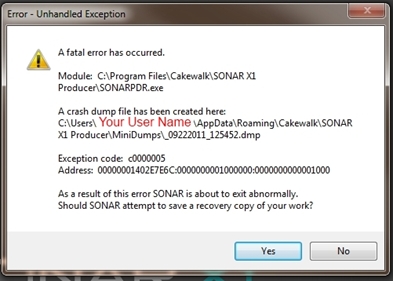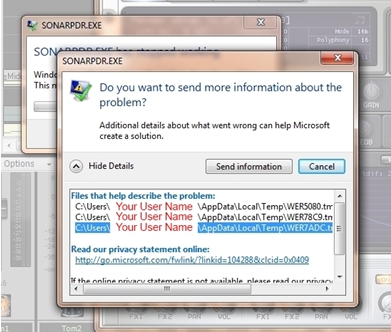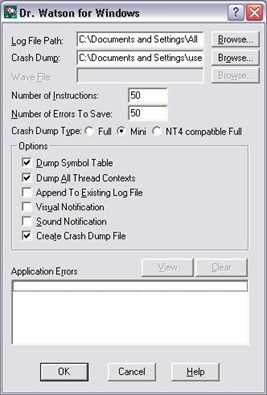How to collect a Minidump file when your Cakewalk program crashes
Last updated on 10/10/2019Note: This article includes legacy information. For up to date instructions on obtaining and reporting crash details, please visit this link.
Minidump files can be an important tool for diagnosing why your application is crashing. It is important to note that this file alone will not often tell the entire story, so it is best to provide a minidump file along with a step-by-step recipe of what you were doing at the time of the crash. Nevertheless, if support is requesting a Minidump file from your system this article can teach you how to obtain one.
Depending on the version of Windows you are running, and the version of Cakewalk software you have installed, there are a few ways to go about collecting a Minidump file. Please select a topic from below to learn more about:
- Collecting files created automatically by your Cakewalk software or Windows
- Creating Dump files when one is not automatically created
- What if SONAR hangs and does not create a crash file?
Collecting files created automatically by your Cakewalk software or Windows
Cakewalk created .dmp files:
Newer versions of Cakewalk software create these files automatically. If you are running a recent version of Cakewalk software and encounter a crash, you might see a message similar to this:

If this is the case, this file can be obtained by doing the following:
- Open the Run Command by holding down the "windows" key on your keyboard and pressing "r"
- Type in the following: %appdata%\Cakewalk
- Click [OK]
- Navigate to your Cakewalk program's folder
- Navigate to the Minidumps folder
- Locate the .dmp files within.
The .dmp files all should contain a timestamp of the time of the crash. So if it is 2/1/2011 at 10:26 am, your file should contain a title similar to "02012011_102620.dmp". This can be useful for locating the correct .dmp file if there are multiple listed.
Windows created .dmp files:
If SONAR does not create a crash file automatically, there are some additional methods for obtaining the file.
If Windows itself pops up an error for message that asks if you wish to send details to Microsoft, similar to below:

Then you can click the "Show Details" button to find the location of the files related to the problem. Sometimes one of these files is a Minidump file itself. Collecting these files will be useful for support.
To access the folder to obtain the files, do the following:
- Open the Run Command by holding down the "windows" key on your keyboard and pressing "r"
- Type in the following: %temp%
- Click [OK]
- Locate the files listed in the error report above
Creating MiniDump files when one is not automatically created
If neither of the above dialogs were given then neither your Cakewalk software nor Microsoft caught the crash. You can manually try to catch these details by manually creating a MiniDump file. This process is different depending on which version of Windows you are running.
If you are running Windows XP:
Windows XP has a built in utility called Dr. Watson for catching details such as this. It must be configured however. To do so, do the following:
- Go to START | RUN and type in the following: drwtsn32
- Click [OK]. This will open the Dr. Watson utility
- Apply the following settings:
- Crash Dump Type: Mini
- Check "Dump Symbol Table", "Dump All Thread Contexts", & "Create Crash Dump File"
- Set "Number Of Instructions" and "Number Of Errors To Save" to 50.
- Uncheck "Append To Existing Log"
- Note the location of the "Crash Dump" path so you can find the minidump file later. If necessary, change it to a better location.
- Confirm that your settings match those in the image below:

- Click [OK]
- At this point, try reproducing the crash you are running into. This should save a Minidump file in the crash dump path location you specified in Step 4 above . The typical file name is "user.dmp".
If you are running Windows Vista & Windows 7:
To create the file:
- While the crash is on screen, open the Windows Task Manager by pressing CTRL + SHIFT + ESCAPE on your keyboard
- Click on the Processes tab and locate the process (SONARPDR, SONARSTD, SONARESL, SONARHS)
- Right-click on the process and choose 'Create Dump File'
To obtain the file:
- Open the Run Command by holding down the "windows" key on your keyboard and pressing "r"
- Type in the following: %temp%
- Click [OK]
- Locate the file. It will be listed after the name of the program that was running (such as SONARPDR.DMP, SONARSTD.DMP, etc.)
What if my software "hangs" and does not create a crash file?
If your software hangs (goes white and/or stops responding but does not give an error code), another useful way of obtaining dump files from hanging applications is to use Microsoft's ProcDump utility. Please note that this is a more advanced technique that requires carefully following the instructions below.
To get started with what this is and how to use it for obtaining a dump for hanging applications, visit http://blogs.msdn.com/b/debugger/archive/2009/12/30/what-is-a-dump-and-how-do-i-create-one.aspx
To use ProcDump to obtain a dump file from hanging SONAR, do the following:
- Download ProcDump from http://technet.microsoft.com/en-us/sysinternals/dd996900.aspx
- Unzip procdump.zip folder
- Repeat the steps that cause your application to hang
- Open Command Prompt by going to Start > All Programs > Accessories > Command Prompt
- In Command Prompt, you will need to type the exact path to where "procdump.exe" is located, followed by the correct command for which process is hanging. For example, if you unzipped your procdump.zip folder to the desktop on a Windows 7 computer, and SONAR Producer is the application that is hanging, you would type the following into Command Prompt:
C:\Users\~YOUR USER ACCOUNT NAME~\Desktop\procdump\procdump.exe -ma SONARPDR.EXE SONARhang.dmp
Note: If you are not using SONAR Producer, replace "SONARPDR.EXE" with the correct process from below:
- For SONAR Studio, use the following: SONARSTD.EXE
- For SONAR Home Studio, use the following: SONARHS.EXE
- For SONAR Essential, use the following: SONARESL.EXE
- After entering "C:\Users\~YOUR USER ACCOUNT NAME~\Desktop\procdump\procdump.exe -ma SONARPDR.EXE SONARhang.dmp" (without quotes) from above, press ENTER on your keyboard
- Command Prompt should tell you that it is "Writing dump file..." and it will tell you when it is done by displaying "Dump written."
- Navigate to the location indicated by Command Prompt and you will be able to find the .dmp file